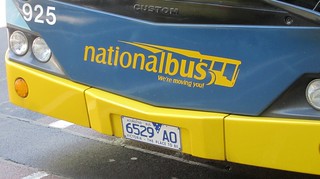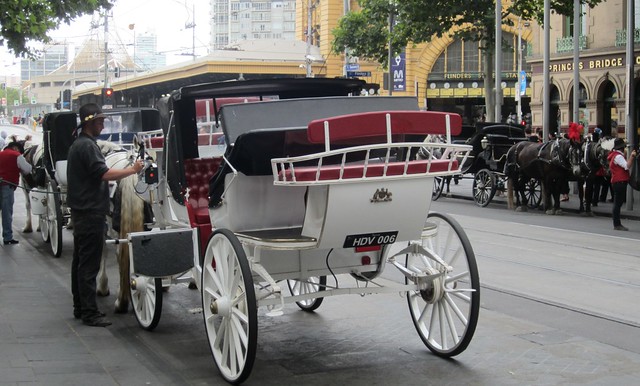The Wikipedia article on Australian licence plates highlights some special prefixes, but here’s a list I’ve tried to come up with that includes others they don’t show, from personal observations and gleaning information from the VicRoads web site.
 Some of them are clearly abbreviations for what they are… some not so much.
Some of them are clearly abbreviations for what they are… some not so much.
AO (suffix) – accredited bus
CC – Consular Corps
E56 – trailers
HDV – horse-drawn vehicle
Mxx – state vehicles, such as (marked) police cars
M – metropolitan Melbourne taxi
U – Geelong, Ballarat or Bendigo urban taxi
PS (suffix) – peak period taxi
ST – substitute taxi (replacement for regular taxi which is out of service for repairs)
C – country/regional taxis
TOW (prefix ) / TT (suffix) – tow truck
VHA/VHB/VHC – hire cars (eg chauffeured)
S000 to S999 – hire motorcycles
I particularly like HDV.
Are there others?

12 replies on “Special licence plates”
In addition to the ‘AO’ suffix seen today, between 2001 and a few years ago buses in Victoria could also use the AC, NC and SO suffixes – standing for Accredited Charter, Non-Commercial and School Operator:
http://www.busaustralia.com/forum/viewtopic.php?f=4&t=66754
And another different format registration plate is that used on the Department of Transport electric vehicle trial – they use the ‘EVT’ suffix:
http://www.flickr.com/photos/legoblock/7179630757/in/set-72157628742577975/
Finally, to prove you can find a website dedicated to anything on the internet, here is an internet forum for Australian registration plate collectors:
http://www.plateshed.com/
Of course the O in AO is for Omnibus, because ‘bus is an abbreviation ;)
And they’re number plates. They have nothing to do with licensing.
With regard to the MXX prefix for state vehicles, the M series in the current three letter three number series have always been reserved for this purpose since the series were introduced in the 1950’s
The idea was the use the one series across the country with NSW getting the set AAA000-FZZ999 and Victoria getting GAA000-MZZ999. The last set were then reserved for state vehicles
http://en.wikipedia.org/wiki/Vehicle_registration_plates_of_Australia#Federal_numbering_scheme
In the old black and white series the plates the first three letter series started with GAA around 1952, then
•HAA in 1959
•JAA in 1964
•KAA in 1968
•LAA in 1971
•IAA was initially skipped for confusion with 1 but then used in 1974
In 1977 they ran out of the old series and went to the green on white series using the original NSW numbers:
•AAA in 1977 (late)
•BAA in 1981
•CAA in 1984
•DAA in 1986 (very late)
•EAA in 1989
•FAA in 1992
Note the plates AAA-ERZ were painted with a poor quality white background that flaked off and the F series were quickly used up as replacements unless you paid a fee to keep the old number. Many F series plates were made in Queensland and have the Queensland plate font.
Then come the blue on white series
•NAA in 1994
•OAA in 1996
•PAA in 1998
•QAA in 1999 (very late)
•RCA in 2001 (RAA000 to RBZ999 were issued oddly in the green on white series)
•SAA in 2002
•TAA in 2004 (TOW skipped for reason above)
•UAA in 2006 (early)
•WAA in 2007
•XAA in 2009
•YAA in 2010
•ZAA in 2012
Trailer plates follow the same pattern as the car plates but only have the first letter and five numbers. They lag the corresponding car plates first letter by a few years. From the 1950’s to 1980s these were white with black lettering.
Come later this year they will run out of the whole set. Note the VAA-VZZ series are missing on top of the VHA hire car series – they have been reserved for use by the Victorian Europlates with the state coat of arms and are still being issued I believe.
Western Australia used to have a wacky system where country residents had plates with a single letter representing the name of their town. Apparently this was so the local cops knew who not to give speeding tickets to.
@Andrew S. Great info. I too recently thought the ZAA series would run out this year. Do you know what will happen then? I presume they can’t start again with say AAA- as there are still some old cars around with these plates. Will they perhaps add another letter or number, making them 7 characters? I’d love to know!
there’s also the ‘historic’ plate series beginning with a single H which I don’t think anyone has mentioned previously – afaicr this is essentially for showroom cars that are occasionally on the road (less than 100 days per year) and require the driver to maintain a logbook.
@ Belinda – not sure – might be one of the following?
New South Wales exhausted all three letter-three number combinations in 2004 (it ran out of its initial Federal allocation AAA000 to FZZ999 in the early 70’s) and then went to two letter-two number-two letter plates; and
South Australia ran out of its old Federal allocation RAA000 to TZZ999 years ago then went through U, V, W, X series. They now put an S in front of the current series with three numbers followed by three letters
Queensland reversed the order and went three numbers-three letters in the late 70’s after running out of its Federal allocation NAA000 to QZZ999 (the Q series was reserved for state use like M in Victoria) Interestingly in the reverse order they still went 000NAA to 999PZZ (excluding the state set) which ran out in the late 80’s then they went back to 000AAA.
Belinda, there is nothing to stop them making new plates with the old combinations, where the cars that previously bore those plates have been “retired”. They can even do this, if some of the cars with plates in those series are still on the road.
When NSW got to the end of the AAA-EZZ plates in 1968, they went back and re-allocated thousands of plates beginning with A’s and B’s in 1969 and 1970, before they started on the FAA-FZZ combinations in 1971.
@ enno – were these retired combinations or were they skipped combinations with I, O or Q in the 2nd or 3rd letter? (similar to I being skipped and later used as the first letter in Victoria)